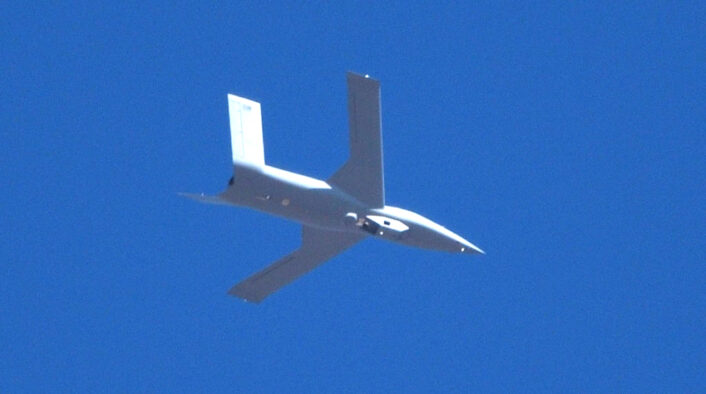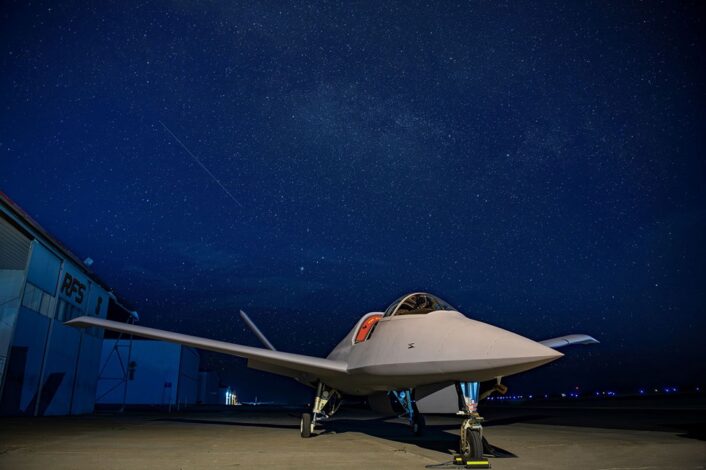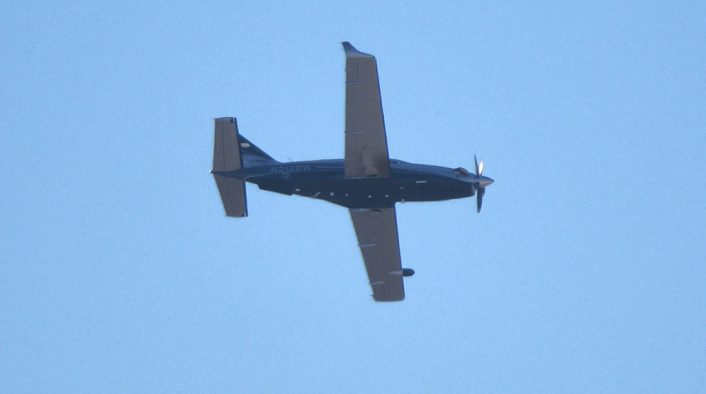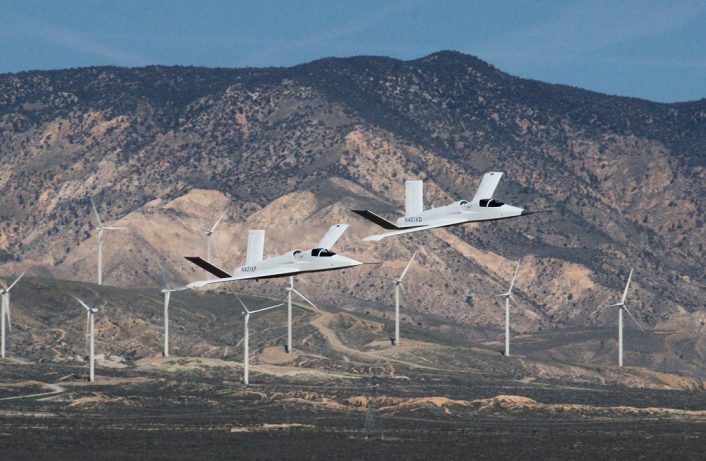The mysterious pod appeared two years ago, but a new artwork might shed some light on its function.
One of the most mysterious aircraft currently being used for flight testing outside of the military is Scaled Composites’ Model 401, also known as “Sierra“ by the company. Scaled Composites is the well-known cutting-edge aerospace company that operates out of Mojave Air and Space Port, California. Now a subsidiary of Northrop Grumman, the company is famous for many exotic aircraft, like the giant Stratolaunch.
As a reference to Scaled Composites’ earlier Agile Responsive Effective Support (ARES) test jet, the two Model 401s are also known as “Sons of Ares”, which is the god of war in Greek mythology. The two aircraft have been therefore further nicknamed Phobos and Deimos, sons of Ares and gods of fear and terror, respectively. The nicknames are also reflected by the registrations of the two jets, N401XP and N401XD, respectively.
The Model 401 Sierra project was developed as clean sheet design for a low-cost manufacturing technology demonstrator aircraft, flown by a single pilot, powered by a single turbofan, and operating at medium altitudes, with two identical vehicles being built. Development took only 24 months from initial concept to the first flight for the first Model 401 in October 2017, followed six months later by the second aircraft.

One of the two jets, Phobos, was spotted a couple of years ago with a mysterious payload under its belly. The pod prominently shows in the front a large air intake containing what could be the radiator of an heat exchanger. In the rear there is a downward-angled exhaust pipe, while on the underside there are a couple of aerial antennas. The right side of the pod shows an aperture that might be related to a sensor. There is also a quite prominent bulge under the fuselage behind the pod.
Close up on the art pic.twitter.com/SSaqdz3tu9
— TaskForce23 (@Task_Force23) October 16, 2022
The same jet was recently spotted while landing at its home airport with the pod still installed, but with the addition of some labels and an interesting artwork. The latter shows a shark with a laser strapped to its head, a reference to the “sharks with freakin’ laser beams attached their heads” scene from the 1997 film Austin Powers. This could indicate the involvement of the Model 401 in the testing of laser systems of some kind.
One of the visible labels near the pod’s exhaust reads “Jet blast – Danger”, meaning that the pod might contain a generator/auxiliary power unit or a heat exchanger that discharges hot air after cooling down whatever system is in inside the pod. Apart from these differences, the aircraft seems to be in the same configuration it was when the pod first appeared.
“Following initial performance envelope expansion, both aircraft conduct payload development testing for a wide variety of customers,” according to Scaled Composites’ website. “The aircraft are able to incorporate a diverse range of payload systems with over 80 cubic feet of internal payload volume and up to 2,000 pounds of payload weight capacity.”

The close-up photos of the artwork were taken by Twitter user @Task_Force23 as the aircraft, radio callsign “Scat 71”, was landing on October 16, 2022. An L-39 Albatros jet trainer was acting as a chase plane. On the following day, the jet was sighted while working over Naval Air Weapons Station China Lake’s ranges, with this time a TBM 700 turboprop (registration N212BW) acting as chase plane.
“She departed Mojave first thing in the morning,” told us our reader and friend Steve Fortson, who took the photos of the somehow mysterious aircraft on Oct. 17, 2022, you can find in this post. “She made two passes over one of the China Lake weapons ranges, before coming back down to Mojave. She was flying with a TBM chase plane.”

“She made multiple passes over where I was sitting, between 10,000 and 15,000 feet, including one pass at 15,000 feet with the landing gear down, after the chase plane landed. She eventually came down and landed, passing not far from me in the pattern.”
The flights are usually visible on flight tracking websites, where Scat 71 is associated to the ICAO hex ID A4B273.
Scaled Composites 401 with a payload. Pretty cool find.
Maybe this? (3rd picture) https://t.co/FDk7hnKn6f pic.twitter.com/gsW7bIwhki
— Centennial State Spotter ✈️ 📸 (@SR_Planespotter) October 16, 2022
Judging by the available flight history recorded through ADS-B, it seems that Phobos resumed flight operations about two weeks ago after the last flights in June. Some of the flights, especially the ones in the vicinity of China Lake, show orbits with an almost lenticular orbit with the concavity in the direction of the ranges, as if the aircraft was pointing some systems to a fixed point on the ground in the distance.
Given the artwork, the pod could potentially contain a laser directed energy system which peers trough the aperture on the right side. The high dihedral wings of the Model 401 could be beneficial for the employment of the laser, as they would be less of an obstruction to the sightline of the system, resulting in a greater field of view. Phobos might also be flying in support of laser-related research work with laser sensors on the ground pointed at the aircraft itself.
We can’t rule out the possibility of test flights for the research of new capabilities to protect an aircraft against directed energy weapons. Let’s not forget that a Model 401 was the first aircraft to be spotted with a mirror-like coating two years ago, before similar coatings appeared on F-22s, F-35As and F-35Cs, and F-117s working with the U.S. Air Force and Navy test and evaluation units.










